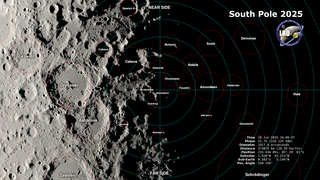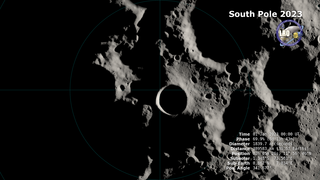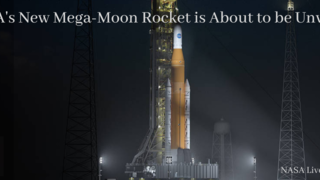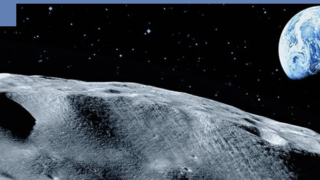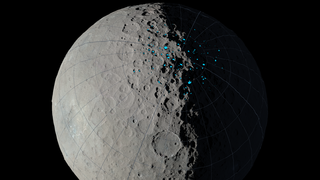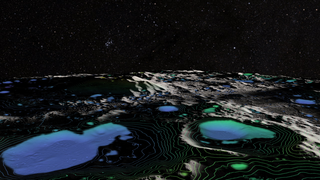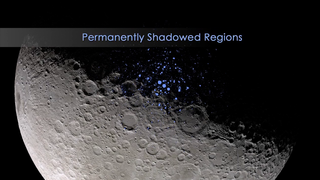Planets and Moons
ID: 4043
The Moon's permanently shadowed regions, or PSRs, are places on the Moon that haven't seen the Sun in millions, or even billions, of years. The Earth's tilted axis allows sunlight to fall everywhere on its surface, even at the poles, for at least part of the year. But the Moon's tilt relative to the Sun is only 1.6°, not enough to get sunlight into some deep craters near the lunar north and south poles. PSRs are therefore some of the coldest, darkest places in the solar system.
Because of that, PSRs are expected to be excellent traps for volatiles, chemicals that would normally vaporize and escape into space, and this includes water. Lunar Reconnaissance Orbiter (LRO) includes several instruments designed to peer into the PSR darkness and measure temperature, reflectivity, and neutron absorption, all of which are clues to what chemicals might be hiding there. This animation shows where the PSRs are and in what ways LRO can see inside them.
LRO Peers into Permanent Shadows
Because of that, PSRs are expected to be excellent traps for volatiles, chemicals that would normally vaporize and escape into space, and this includes water. Lunar Reconnaissance Orbiter (LRO) includes several instruments designed to peer into the PSR darkness and measure temperature, reflectivity, and neutron absorption, all of which are clues to what chemicals might be hiding there. This animation shows where the PSRs are and in what ways LRO can see inside them.
Related
Visualization Credits
Ernie Wright (USRA): Lead Animator
Dan Gallagher (USRA): Producer
John Keller (NASA/GSFC): Scientist
Dan Gallagher (USRA): Producer
John Keller (NASA/GSFC): Scientist
Please give credit for this item to:
NASA's Goddard Space Flight Center Scientific Visualization Studio
NASA's Goddard Space Flight Center Scientific Visualization Studio
Short URL to share this page:
https://svs.gsfc.nasa.gov/4043
Missions:
Clementine
LRO (Lunar Reconnaissance Orbiter)
Data Used:
Note: While we identify the data sets used in these visualizations, we do not store any further details nor the data sets themselves on our site.
This item is part of these series:
The Moon
LRO - Animations
Keywords:
SVS >> Elevation data
SVS >> HDTV
SVS >> Laser Altimeter
SVS >> Lunar
SVS >> Moon
SVS >> Neutron
SVS >> LRO
SVS >> Lunar Reconnaissance Orbiter
SVS >> LOLA
SVS >> LEND
SVS >> LAMP
SVS >> Diviner Lunar Radiometer Experiment (DLRE)
SVS >> Lunar Surface
SVS >> Lunar Topography
SVS >> Lunar Surface Temperature
SVS >> Lunar Elevation Map
NASA Science >> Planets and Moons
https://svs.gsfc.nasa.gov/4043
Missions:
Clementine
LRO (Lunar Reconnaissance Orbiter)
Data Used:
LRO/Diviner
Clementine/UVVIS Camera/750-nm Basemap
MosaicLRO/LOLA/Digital Elevation Map also referred to as: DEM
LRO/LEND/Neutrons
DatabaseLRO/LAMP/Lyman alpha and UV also referred to as: LRO LAMP
Data CompilationThis item is part of these series:
The Moon
LRO - Animations
Keywords:
SVS >> Elevation data
SVS >> HDTV
SVS >> Laser Altimeter
SVS >> Lunar
SVS >> Moon
SVS >> Neutron
SVS >> LRO
SVS >> Lunar Reconnaissance Orbiter
SVS >> LOLA
SVS >> LEND
SVS >> LAMP
SVS >> Diviner Lunar Radiometer Experiment (DLRE)
SVS >> Lunar Surface
SVS >> Lunar Topography
SVS >> Lunar Surface Temperature
SVS >> Lunar Elevation Map
NASA Science >> Planets and Moons
